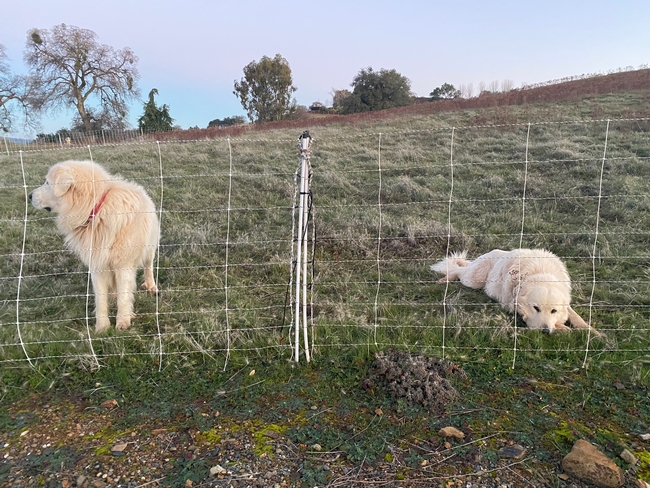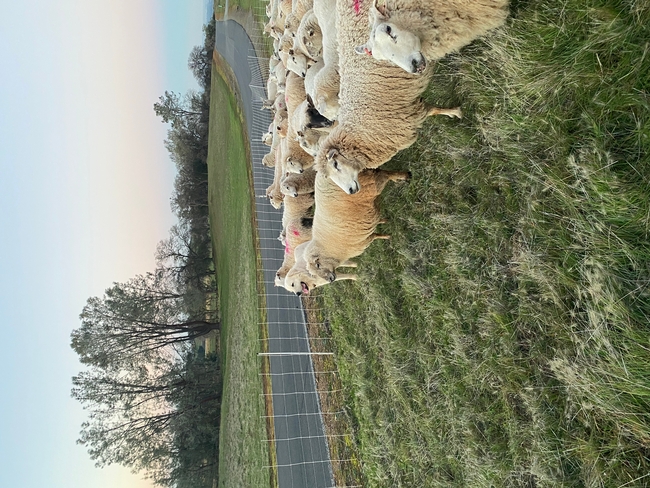Predator Protection in Rangeland Livestock Operations
One of the first projects I worked on when I started this job was a publication called Livestock Protection Tools for California Ranchers. Working with a number of other advisors and extension specialists, we took a detailed look at the variety of “tools” that ranchers could use to protect their livestock from predators – everything from livestock guardian dogs to electric fencing, and every predator from neighbor dogs to gray wolves. But as I've studied livestock-predator conflict more thoroughly, and as I've thought about how I protect my own sheep from predators, I've come to think that maybe “tool” is the wrong word. Protecting livestock from predators on rangeland takes a systems approach – one that reflects the overlapping ecology of grazing livestock and rangeland predators. A system that reflects an understanding of human, livestock, and predator behavior – and how these behaviors interact.
I'll use our sheep operation to illustrate what I'm trying to say here. We graze just shy of 100 wool-breed ewes on annual rangeland, irrigated pasture, and irrigated crop land, all within 7 miles of Auburn. The predators we've observed in our environment include mountain lions, black bears, coyotes, foxes, bobcats, domestic dogs, and golden and bald eagles. We also have birds that other producers might include on this list – crows and magpies. We lamb from late February through the end of March (when the grass on our annual rangelands is starting to grow rapidly). We move to irrigated pasture in April. In late June, we wean the lambs and sell most of them; the lambs we keep stay on irrigated pasture, while the ewes move back to annual rangeland. In late August, the ewes come back to irrigated pasture and/or cropland, where they stay through flushing and breeding. In early December, the entire flock moves back to annual rangeland.
Predator pressure varies by location and time of year. We tend to see more wild predators on annual rangeland, although we have seen coyotes in our irrigated pastures. We see more domestic dogs closer to town. We see eagles rarely, but we do see them. We have trail camera photos of a mountain lion within 30 yards of the paddock where we were lambing several years ago. We have too many photos of coyotes to count.
Mostly, we rely on our livestock guardian dogs and our electro-net fencing to keep predators away from our sheep. We know they work – because we've lost sheep where we didn't have both tools (in hard-wire fences without a dog), but I couldn't tell you which “tool” was more important. We've also used FoxLights™ - a randomly flashing light that supposedly deters coyotes and foxes. When we have sheep at home, we'll put them in a secure pen at night (e.g., night-penning) if we need to.
But our system encompasses more than dogs and fencing. We move the sheep every 3-7 days for most of the year. Mostly these are moves to an adjacent pasture, but I suspect the fact that the sheep are never in the exact same spot for very long helps confound the predators to some degree. We add dogs – and more human presence – during lambing, when we're especially vulnerable. We have focused on ewe genetics on maternal qualities – which for us includes vigorous lambs and protective ewes who can keep track of their young.
All of this might seem to be a matter of perspective – or vocabulary! One rancher's “toolbox” might be another rancher's “system.” But as we start talking about impacts from predators, and the costs associated with these impacts, I've come to think we need to take a broader view.
The California Department of Fish and Wildlife received funding in last year's budget to help offset the cost of nonlethal predator deterrents for ranchers. By taking a systems perspective on this question, I think we can help the agency understand that most producers are already doing things to mitigate predator problems. Rather than asking, “what tools are you using?” we should be asking, “How have you changed your management to avoid conflict with predators?” Are there parts of your range you don't use during certain times of year? Are you riding through the heifer field more often? Are you adding extra livestock guardian dogs to your operation so you have enough dog power during lambing or kidding? Are you giving up leases because the predator pressure is just too intense? Some of these are “tools,” obviously, but some are systematic changes to our operations. Regardless, they all have costs. And in my mind, they should all be considered when it comes to any kind of predator deterrent cost-sharing program.
Finally, all of these systematic considerations regarding predators have to fit within the larger context of our ranching systems. Not only do we need to think about avoiding or resolving conflicts with predators, we have to think about our marketing windows. We have to fit our genetics both to our environment and to the marketplace. We need to consider the cost of – and return to – labor (our own labor as well as that of our employees, if we have any). We need to think about short term cash flow and long term investment. We often need to satisfy the needs of our landlords, our families, our bankers, and others connected to our businesses. We have to be good neighbors. This larger context influences the choices we have available to us when it comes to predator protection. For me, the idea of a system (as opposed to a tool box) better reflects the complexity of coexisting with wildlife.

